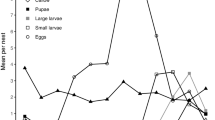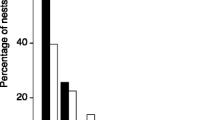Summary
In the present paper, the nest structure ofHalictus duplex Dalla Torre was described in detail, from both static and dynamic aspects, together with descriptions of immature stages. This comb-making species shows the highest degree of architectural development, nevertheless its social differentiation is not so high as inH. malachurus Kirby andH. marginatus Brullé, nests of which remain still in a less developed stage.
Zusammenfassung
In der vorliegenden Arbeit, wurden die Beschreibungen des Nestbaues vonHalictus duplex Dalla Torre ausführlich gegeben, sowohl statisch als auch dynamisch, nebst die Beschreibungen der Entwicklungsstadien. Diese wabenerzeugende Art zeigt baukünstig den höchsten Entwicklungsgrad, obgleich ihre soziale Differenzierung nicht so hoch ist wie beiH. malachurus Kirby undH. marginatus Brullé, deren Nester noch in einem ursprünglicheren Zustand bleiben.
Résumé
Cet article concerne la structure du nid deHalictus duplex Dalla Torre, envisagée sous un double aspect statique et dynamique. Les stades préimaginaux de cette espèce sont également décrits.Halictus duplex, dont le nid montre une complexité architecturale poussée au plus haut point, n'atteint pas, cependant, un degré de différenciation sociale aussi élevé queHalictus malachurus Kirby etHalictus marginatus Brullé dont les nids sont de type beaucoup plus simple.
Similar content being viewed by others
Literature Cited
1931.Aptel (E.).—Étude sur les nidifications de l'Halictus malachurus Kirby (formalongulus) génération d'été (Bull. Soc. Ent. France, 1931, 219–222).
1941.Baerends (G. P.).—Fortpflanzungsverhalten und Orientierung der GrabwespeAmmophila campestris Jur. (Tijdschr. Entom., 84, 1–275).
1948.Bonelli (B.).—Osservazioni biologiche sull'Halictus malachurus Kirby (Boll. Ist. Entom. Univ. Bologna, 17, 22–42).
1926.Claude-Joseph (F.).—Recherches biologiques sur les hyménoptères du Chili (Mellifères) (Ann. Sci. Nat., Zool., 10 ser. 9, 113–268).
1925.Legewie (H.).—Zur Theorie der Staatenbildung. I. Teil. Die Biologie der Furchenbiene.Halictus malachurus K. (Zs. Morph. Oekol. Tiere, 3, 619–684).—Legewie (H.). II. Teil. (Ibid., Zs. Morph. Oekol. Tiere, 4, 246–300).
1936.Malyshev (S. I.).—The nesting habits of solitary bees. A comparative study. (Eos, 11, 201–309).
1953.Michener (C. D.).—Comparative morphological and systematic studies of bec larvae with a key to the families of hymenopterous larvae. (Univ. Kansas Sci. Bull., 35, 987–1102).—Michener (C. D.) 1954. Observations on the pupae of bees (Pan-Pacific Entom., 30, 63–70).
1958a.Michener (C. D.), Lange (R. B.).—Observations on the behavior of Brazilian halictid bees (Hym., Apoidea), II.Paroxystoglossa jocasta (J. Kansas Entom. Soc., 31, 129–138).—Michener (C. D.), Lange (R. B.) 1958b. III. (Univ. Kansas Sci. Bull., 39, 473–505). —Michener (C. D.), Lange (R. B.) 1958c. V.Augochloropsis (Amer. Mus. Nov., 1924, 41 pp.).—Michener (C. D.), Lange (R. B.). 1958d V.Chloralictus (Insectes Sociaux, 5, 379–407).
1931.Noll (J.).—Untersuchungen über die Zeugung und Staatenbildung desHalictus malachurus (Zs. Morph. Oekol. Tiere, 23, 285–368).
1955.Quénu (C.).—Sur le cycle biologique deHalictus marginatus (Brullé) (C. R. Acad. Sci., Paris, 241, 1512–1514).—Quénu (C.). 1957. Sur la fondation du nid chezHalictus Marginatus (Brullé) (Ibid., C. R. Acad. Sci., Paris, 1548–1550).—Quénu (C.). Sur la possibilité d'une inhibition des ouvrières par la reine chezHalictus marginatus (Brullé) (Ibid., C. R. Acad. Sci., Paris, 245, 1102–1104). —Quénu (C.) Sur l'existence de castes chezHalictus marginatus (Brullé) (Ibid., C. R. Acad. Sci., Paris, 246, 1294–1296)
1937.Rayment (T.).—Biology of a new halictine bee and specific description of its parasites (Arb. physiol. angew. Entom., Berlin-Dahlem, 4, 30–60).
1958.Sakagami (Sh. F.), Hayashida (K.).—Biology of the primitive social bee,Halictus duplex Dalla Torre. I. Preliminary report on the general life history. (Annot. Zool. Jap., 31, 151–155).
1960.Sakagami (Sh. F.), Michener (C. D.).—Nest structure of halictine bees. A bibliographical analysis (In preparation).
1906.Semichon (L.).—Recherches sur les Mellifères solitaires (Bull. Sci. France Belg., 40, 281–442).
1897.Verhoeff (C.).—Zur Lebensgeschichte der GattungHalictus (Anthophila), insbesondere einer Uebergangsform zu socialen Bienen (Zool. Ang., 20, 369–393).
1939.Weyrauch (W.), Die allgemeine Prinzipien der Zusammenarbeit bei sozialen Insekten, nach Feststellungen anVespa undDolichovespula (Verh. 8 Intern. Kongr. Entom., Berlin, 2, 980–984).
Author information
Authors and Affiliations
Additional information
Contribution No. 461 from the Zoological Institute, Faculty of Science, Hokkaido University, Sapporo, Japan.
Rights and permissions
About this article
Cite this article
Sakagami, S.F., Hayashida, K. Biology of the primitive social bee,Halictus duplex Dalla Torre II. Nest structure and immature stages. Ins. Soc 7, 57–98 (1960). https://doi.org/10.1007/BF02225757
Issue Date:
DOI: https://doi.org/10.1007/BF02225757




